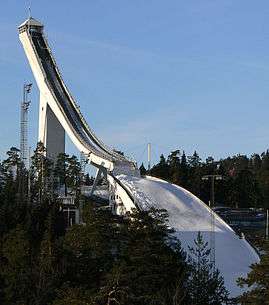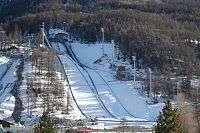Ski jumping
|
| |
| Highest governing body | International Ski Federation (FIS) |
|---|---|
| First played |
22 November 1808 Olaf Rye, Eidsberg church, Eidsberg, Norway |
| Characteristics | |
| Team members |
M Individual (50) L Individual (40) Team event (4) |
| Type | Nordic skiing |
| Equipment | skis |
| Venue |
Asia Europe North America |
| Presence | |
| Olympic |
1924 (men) 2014 (ladies) |
| World Championships |
1925 (men's nordic) 1972 (ski flying) 2009 (ladies' nordic) |

first ever jumps over 100 metres (1936) and 200 metres (1994) happened here

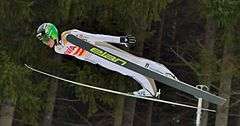

Ski jumping is a form of Nordic skiing in which athletes descend a specially constructed takeoff ramp (known as the inrun), jump from the end of it (the table) with as much power as they can generate, and "fly" as far as possible down a steeply sloped hill.[1] Points are awarded for distance and style by five judges, with competition sanctioned by the International Ski Federation (FIS). To enable the athletes (who are known as ski jumpers) to effectively glide such long distances and land safely, the skis they use are considerably wider and longer than their cross-country and alpine skiing counterparts. Ski jumping is predominantly a winter sport and has been part of the Winter Olympic Games since its inception in 1924 for men and since 2014 for women.[2] Since 1954 it is possible to ski jump in summer on artificial surfaces made from plastic. Along with cross-country skiing, ski jumping is one of two sports which form the Nordic combined discipline. Holmenkollbakken in Oslo is the holy place of this sport, which is most popular in Austria, Germany, Finland, Japan, Norway, Poland and Slovenia.
History
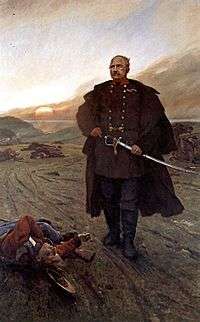
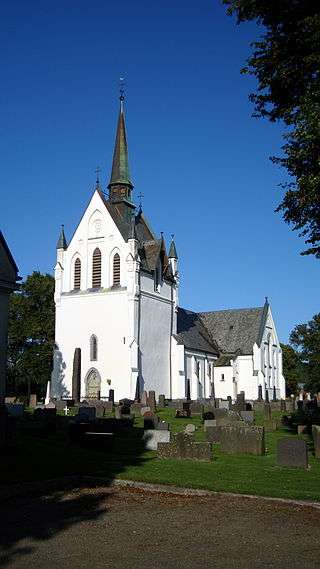
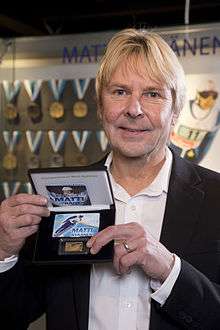
.jpg)
Slovenian engineer is a world's greatest ski jumping constructor, specialized in ski flying hills. He built over 100 hills around the world


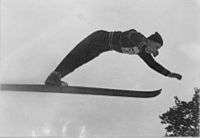
arms forward style (1949)
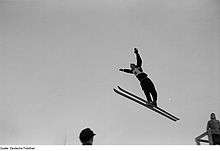
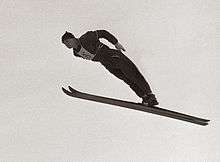
Windisch technique (1958)
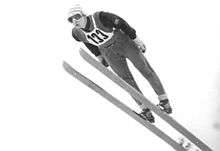
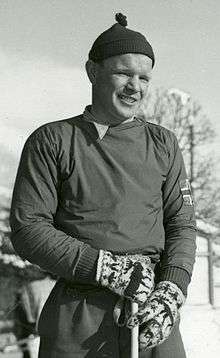
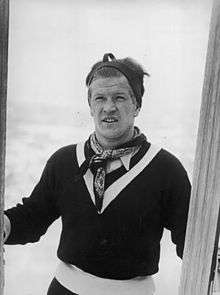
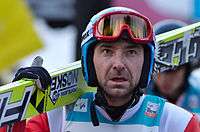
1796: First experiments
According to the sources of Dutch naval officer Cornelius de Jong from his book Reizen naar de kap, first ski jumping experiments dates back to 1796. In this book it's described, how that year soldiers of some Norwegian ski company used house and barn roofs as ski jumping hills and discovered that the hard landing could be reduced by jumping on a steep slope.
1808: Rye's first jump ever
The recorded origins of the first ever real ski jump can be traced directly to 22 November 1808 in which Danish-Norwegian lieutenant Olaf Rye launched himself 9.5 metres (31 ft) in the air as a show of courage to his fellow soldiers near Eidsberg church in Eidsberg, Norway.[3][4]
1862: First competition/style points
The very first organized and recorded public competition was held at Trysil, Norway, on 22 January 1862. At this first competition, judges already awarded points for style ("elegance and smoothness"), participants had to complete three jumps without falling and rules were agreed upon in advance.[5] It is clear from the news report published in Morgenbladet that the ski jumping in Trysild was entertainment, but also a national, competitive sports event.
1866: First event in Christiania
In 1866, the first skiing event was held in Oslo/Christiania near Old Aker Church was a combined cross-country, slalom and jumping competition, and attracted an audience of some 2,000 people.[6]
1868: Norheim invented telemark
Norwegian skier and pioneer of modern skiing Sondre Norheim won his first competition in Christiania in 1868 and set the second ever world record in ski jumping at 19.5 metres (64 ft).[6] Norheim is known as the father of Telemark skiing who practised downhill skiing as a recreational activity, rising to local fame for his skills. He made important innovations in skiing technology by designing new equipment, such as different bindings and shorter skis with curved sides to facilitate turns. He also designed the Telemark ski, which is the prototype of all those now produced. Sondre Norheim was regarded by his contemporaries as a master of the art of skiing. He combined ordinary skiing with jumping and slalom.
1879: Husebyrennene
The first widely known ski jumping competition was the Husebyrennene, held in Oslo in 1879, with Olaf Haugann of Norway setting the first world record for the longest ski jump at 20 meters.[7] Explorer Fridtjof Nansen was a skilled skier and was number 7 in the 1881 competition at Huseby.[6] Until 1884–1886 jumping and cross-country was a single integrated competition: In 1886 at Huseby cross-country and jumping were held on separate days, and final results were calculated from the combined achievements (similar to present nordic combined).[6]
1892: Holmenkollen
The annual event was moved from Husebyrennene to Holmenkollen in 1892, and Holmenkollen has remained the pinnacle of ski jumping venues. To distinguish ski jumping competition only from Nordic combined, it is still referred to as spesielt hopprenn in Norwegian (ski jumping only). Until 1933 there were no "jumping only" national championships in Norway, only Nordic combined. International championships in ski jumping only were introduced in the 1920s.[8]
1918: Kongsberger technique
The Kongsberger technique (Norwegian: Kongsbergknekk) was created by Norwegian ski jumpers Jacob Tullin Thams and Sigmund Ruud in Kongsberg, Norway and developed after World War I. The technique was characterised by the athlete's upper body being bent at the hip, with arms extended at the front and skis held parallel to each other. Sometimes the arms would be waved or 'flapped' around vigorously in a bird-like manner. This technique extended jumping lengths from 45 metres (148 ft) to over 100 metres (330 ft), and was used in ski jumping until being superseded by the Windisch and Däscher techniques in the 1950s.[9]
1924: Olympic premiere
Men's ski jumping has been on the Winter Olympics Games program since the first edition in 1924 being held only on normal hill. Norwegian ski jumper Jacob Tullin Thams was the first ever Olympic ski jumping gold medalist.
1925: World Championships premiere
FIS Nordic World Ski Championships was for the first time organized in 1925 in Janské Lázně, Czechoslovakia only on large hill. Czechoslovakian ski jumper Willen Dick became the first ever Nordic world champion.
1929: Japan joined the family
In 1929, Norwegian instructors arrived in Sapporo to train the Japanese in ski jumping.[5] Two years later large hill was opened in Sapporo which to thid day still remains the national ski jumping center. Japan became and is for decades now one of the world's leading ski jumping nations who produced many legends and champions until this day.
1934: Planica opening event
On 4 February 1934 the hill, unfairly named the Bloudkova velikanka (Velika Rožman/Bloudkova skakalnica), was opened with the Kingdom of Yugoslavia National championships. The winner was Franc Palme from Kingdom of Yugoslavia (now Slovenia). With 55 and 60 meters he set the first two hill records and the national record at the same time. In March they organized the first international competition when Birger Ruud set the first world record in Planica with 92 meters.[10] Later his brother Sigmund Ruud touched the snow at 94 meters, a world record distance. This hill dominated as the world's largest hill for sixteen years in a row with total of thirteen world records.
1936: Bradl first over 100 metres
On 15 March 1936 Austrian Sepp Bradl was the first man in history to have officially jumped over one hundred meters at Bloudkova velikanka in Planica. He actually jumped 101.5 meters and not 101 metres, which had to be displayed on the scoreboard due to not enough space and wrongly spread into newspapers for many years. That day a new discipline called ski flying was born.
1938: Congress in Helsinki
This year Joso Gorec, Slovenian visionar who founded Planica Nordic Centre, went to the regular International Ski Federation congress in Helsinki where he was defending bold plans of Stanko Bloudek and fighting for recognition of the Ski flying discipline, which FIS was against. He was supported by Sir Arnold Lunn, who said FIS simply couldn't prevent sky flying competitions. Lunn also had big problems with FIS not recognizing slalom and downhill disciplines. Reinhard Straumann also joined Joso Gorec and support him in this initiative. FIS finally allowed ski flying competitions but only for study purposes.
1949: Windisch technique
Windisch was created by German ski jumper Erich Windisch in 1949, which was a modification of the Kongsberger technique. The athlete's arms are instead placed backwards toward the hips for a closer, more aerodynamic lean.
1953: Four Hills Tournament
Prestigious Austrian/German Four Hills Tournament (original: Vierschanzentournee) was for the first time organized on 1 January 1953. Legendary Austrian ski jumper Sepp Bradl won the first tournament title.
1954: Summer debut on plastic
Plastic cover for ski jumping was invented by East German ski jumper Hans Renner. First ski jumping tests on plastic without any audience were already made on 31 October 1954 at »Regenbergschanze« in Zella-Mehlis, East Germany. But the »Wadeberg Jugendschanze K40« in Oberhof, which was built just next to the old »Thüringenschanze«, officially became the world's first plastic covered ski jumping hill. On 21 November 1954 they organized here the first ever summer competition on plastic infront of 15,000 spectators and Werner Lesser set first two ever plastic/summer world records of 41 and 42 metres (135 & 138 ft).
The Däscher technique or parallel style[11] was created by Andreas Däscher somewhere in the 1950s, as a modification of the Kongsberger and Windisch techniques. No longer was the upper body bent as much at the hip, enabling a flatter, more aerodynamic position in the air. This style became the standard for ski jumping as a whole until the development of the V-style. In the 1980s, the parallel style saw a variation in which the skis were pointed diagonally off to the side in order to increase surface area, essentially forming a half "V".[12]
A new Heini-Klopfer-Skiflugschanze in Oberstdorf, West Germany was opened in early 1950s and this whole decade dominated as the biggest hill in the world, firmly holding the world record.
1956: First ever live broadcast
German television ARD produced first ever ski jumping live broadcast signal on a New Year's day in 1956 from Garmisch-Partenkirchen event at Four Hills Tournament.
1962: K.O.P., computer measuring
K.O.P. (Kulm-Oberstdorf-Planica), an association of ski flying hills was originally founded on initiative of Danilo Dougan and other organizers in Ljubljana in 1962.[13] Vikersund, Copper Peak and Harrachov joined later.
Technical development also reached this sport. In 1962 they first time measured the distances with the help of computers, before that using only hand measurements.
1966: Vikersund became flying hill
In 1936 Vikersundbakken in Norway was originally built as a large hill. Since 1966 when it was renovated, it was converted and categorized into the ski flying hill. Two new world records were set this year.
1969: V-style by Mirosław Graf
Mirosław Graf, a Polish ski jumper from Szklarska Poręba originated V-style. As early as 1969 Graf discovered the technique as a child, but it was not taken seriously by his contemporaries. He was nonetheless aware that the V-style was highly effective, as his jumps became considerably longer.
In 1969 also famous Letalnica bratov Gorišek, a ski flying hill with the most world records, was opened in Planica. An opening event gathered total of 90,000 people who saw five world records.
1972: First Ski Fly World Champs
First ever FIS Ski Flying World Championships was organized at Planica in 1972, which was decided a previous year at International Ski Federation congress in Opatija. A new format of total four rounds in two days for final standings was introduced because of the strong wind risk. And that's what exactly what happened already on the first championships: two of four scheduled round were canceled because of the weather conditions.
1979: World Cup was founded
The FIS Ski Jumping World Cup was founded by ex Norwegian ski jumper Torbjørn Yggeseth, with the men's premiere 1979/80 season. First event was held on 27 December 1979 at normal hill in Cortina d'Ampezzo, Italy. Austrian ski jumper Toni Innauer won this premiere event and became the first ever World Cup winner.
1982: Men's team event debut
First official men's team event was organized at FIS Nordic World Ski Championships 1982 in Oslo, Norway. Team of Norway (Johan Sætre, Per Bergerud, Ole Bremseth, Olav Hansson) won this event. Although first ever men's team event was held already at FIS Nordic World Ski Championships 1978 in Lahti, it was just an unofficial demonstration event that didn't count for medals.
1986: Rule of 191 m established
In 1986 current World Cup director and founder Torbjørn Yggeseth decided to establish the rule where no jumps exceeding 191 metres (627 ft) will be additionally scored, after Matti Nykänen jumped this unbelievable distance previous year in Planica. With excuse that flying that far is dangerous, International Ski Federation wanted to stop the unbelievable fast progress of ski flying. But it was obvius, that especially strong Norwegian officials were very mad and jealous at Planica, who was dominating in their sport and they didn't allow that. After eight years in use this unreasonable rule was finally canceled.
1990: Qualifications introduced
Qualifications were for the first time introduced in the 1990/91 FIS Ski Jumping World Cup season to limit the number of competitors, sometimes over hundred. And to give the event and television broadcast reasonable time.
1993: New scoring system
After the original scoring system was in use for the first fourteen season, the new World Cup scoring system was introduced for the first time on 11 December 1993 at World Cup event in Planica and is still in use today.
1994: Nieminen first over 200 metres
On 17 March 1994 first official training round of the 13th FIS Ski Flying World Championships at Letalnica bratov Gorišek flying hill in Planica, Slovenia was on the schedule. Austrian Andreas Goldberger was actually the one, who became the first man in history who over jumped two hundred metres. Unfortunately he glided and touched the snow with his hands at 202 metres (663 ft) and it didn't count as valid jump. Just a few minutes later Finnish Toni Nieminen stood on his feet at 203 metres (666 ft) and became the first man in history to have officially over jumped two hundred metres mark.
Unreasonable and crazy rule of not scoring the jumps over 191 metres (627 ft), with purpose of limitating ski flying progress, was finally canceled after eight years in use at the International Ski Federation at Rio de Janeiro in 1994.
The first edition of top level summer competition FIS Ski Jumping Grand Prix, premiered on 28 August 1994 in Hinterzarten, Germany. First ever Grand Prix winner became Japanese Takanobu Okabe.
1996: Four Hills K.O system
K.O. (Knock Out) system was first time used at the 1996/97 Four Hills Tournament. It means that top 50 jumpers in qualifications are divided into 25 pairs, who are competing against each other in the first round of competition. A total of 30 competitors advance to final round: all 25 pair winners and 5 lucky losers by best results. The are competing by the system best versus worst results in qualifications: 25th vs 26th, 24th vs 27th...2nd vs 49th and 1st vs 50th. In the final round they compete by the old classic backward system from 30th to 1st place. This system is still and only used at this tournament, all other competitions use classic system.
2002: Hannawald achieved poker
German ski jumper Sven Hannawald won the 50th edition of the prestigious Four Hills Tournament (Vierschanzentournee) in 2001/02, as first and still the only one in history to win all four hills in a single tournament or achieving poker.
2010: Gate/wind factor introduced
Gate and wind factor compensation was first time introduced at Ski Flying World Cup men's team event in Oberstdorf, Germany on 30 January 2010 and winner was team of Austria.[14][15]
A revolutionary new bindings were designed by Slovenian innovator Peter Slatnar, which were for the first time used by Simon Ammann at the 2010 Winter Olympics where he won two gold medals.
2012: Mixed team premiere
The first ever ski jumping mixed team event, actually pairs of one man and one woman, was held on 15 June 2012 on plastic, at ski jumping complex located in Šiška District at Mostec, Ljubljana, Slovenia.[16][17] Mixed team pairs competed on four different hills HS14, HS23, HS38 and HS62 with each other by rules of elimination system. Slovenian pair Maja Vtič and Tomaž Naglič won the first ever mixed team (pairs) competition.[18]
First ever mixed team with four members event, two men and two ladies, was held in 2012 FIS Grand Prix Ski Jumping season, was held on plastic at Olympic HS96 normal hill in Courchevel, France. First ever mixed four members team event was Japan.
The first World Cup mixed team event took in place at Lysgårdsbakken HS100 hill in Lillehammer, Norway in 2012. Competition was held on normal. The first World Cup mixed team winner was Norway.
2016: Tandem, Kasai, Prevc
On 18 February 2016 Slovenian ski jumpers Rok Urbanc and Jaka Rus made a historic first ever 35 metres (115 ft) world record tandem ski jump both on one pair of longer skis at HS45 hill in Planica, Slovenia.[19]
Japanese Noriaki Kasai made the 500th World Cup individual performance. Slovenian Peter Prevc broke all the records in a single World Cup season: most wins, most podiums and most points in overall ranking.
In 2016 the two new ski manufactures premiered in the circuit and replaced the two brands that stopped the production: German company Verivox replaced Fluege.de and Slovenian company Slatnar replaced Elan.[20]
Invention by Slovenian manufacturer, with LED lights illuminated inrun track, was first time presented to the public at International Ski Federation fall meeting 2016 in Zürich. First time they will use it in December 2016 at men's World Cup event in Engelberg, since they completely renovated the hill and equipped their new inrun track with it.[21]
2017: Raw Air premiere
The 1st edition of Raw Air tournament in Norway will be held between 10–19 March 2017. It will take place on four different hills in: Oslo, Lillehammer, Trondheim and Vikersund. It will last with no break for 10 days in a row with total of 16 rounds to be calculated in overall standings: 8 rounds from four individual events, 4 rounds from two team events and all 4 qualifications rounds. Qualification round is called prologue and individual two rounds results from each team event will count in overall standings. The competition will have prize money of €100,000 in total for top three competitors in overall standings: €60,000 for the title, for second place €30,000 and for third place in overall €10,000.
Summer jumps on plastic
Ski jumping can also be performed in the summer on an inrun where the tracks are made from porcelain and the grass on the slope is coated with plastic, combined with water. However, not all hills are equipped with these facilities. There are also many competitions during the summer, including the highest level FIS Ski Jumping Grand Prix series since 1994.
Russian ski jumper Dimitry Vassiliev holds the summer world record on plastic with 147.5 metres (484 ft) which he set at at the Russian National Championships on 15 October 2016 in Sochi, Russia.
Techniques
Each jump is divided into four parts: in-run, take-off (jump), flight and landing. To each part the athlete has to pay attention to and practice a particular technique in order to maximize the outcome of ultimate length and style marks.
Using the V-style, popularised in late 1980s by Jan Boklöv from Sweden and Jiří Malec from Czechoslovakia, skiers are able to exceed the distance of the take-off hill by about 10% compared to the previous technique with parallel skis. Previous techniques first included the Kongsberger technique, the Däescher technique and the Windisch technique.[22] Until the mid-1960s, the ski jumper came down the in-run of the hill with both arms pointing forwards. This changed when the Däscher technique or parallel style[2] was created by Andreas Däscher in the 1950s, as a modification of the Kongsberger and Windisch techniques.
The landing requires the skiers to touch the ground in the Telemark landing style (Norwegian: telemarksnedslag). This involves the jumper landing with one foot in front of the other, mimicking the style of Telemark skiing. Failure to comply with this regulation leads to the deduction of style marks (points).[8]
Competition
Run by International Ski Federation by level: Winter Olympics, Nordic World Championships, Ski Flying World Championships, World Cup, Grand Prix, Continental Cup, FIS Cup, FIS Race and Alpen Cup.
Normal hill
There are rare competitions on normal hills in the men's World Cup, but most of them in the ladies' World Cup. There are both Nordic World Championship and Olympics organized. Distances over 110 metres (360 ft) can be reached.
Large hill
There are most competitions on large hills in the men's World Cup, but very few in the ladies' World Cup. There are both Nordic World Championship and Olympics organized. Distances over 150 metres (490 ft) can be reached.
Ski flying hill
There are only World Cup and Ski Flying World Championships are organized on ski flying hills. Trainings are impossible. Only few ladies had privilege to fly. Distances over 240 metres (790 ft) can be reached easily.
Hill classification
| Classified | Code | Calculation line (K-point) | Hill size (HS) | ||
|---|---|---|---|---|---|
| Metres | Feet | Metres | Feet | ||
| Small hill | SH | <45 | <148 | <50 | <164 |
| Medium hill | MH | 45–74 | 148–243 | 50–84 | 164–276 |
| Normal hill | NH | 75–99 | 246–325 | 85–109 | 279–358 |
| Large hill | LH | 100–169 | 328–554 | 110–184 | 361–604 |
| Ski flying hill | FH | ≥170 | ≥558 | ≥185 | ≥607 |
Scoring and rules
The winner is decided on a scoring system based on distance, style, inrun length, gate factor and wind conditions. In the individual event, the scores from each skier's two competition jumps are combined to determine the winner.
Equipment
Skis must be between 9 to 10 cm (3.5 to 4 inches) wide and between 240 do 270 cm (94 to 106 inches) long. All ski jumpers are now using Slatnar's revolutionary carbon fibre bindings invention with curved sticks in the back.
Suits regulations
Aerodynamics has become a factor of increasing importance in modern ski jumping, with recent rules addressing the regulation of ski jumping suits. This follows a period when loopholes in the rules seemed to favour skinny jumpers in stiff, air foil-like suits.
Body mass index
Ski jumpers below the minimum safe body mass index are penalized with a shorter maximum ski length, reducing the aerodynamic lift they can achieve. These rules have been credited with stopping the most severe cases of underweight athletes, but some competitors still lose weight to maximize the distance they can jump.[23]
Gate factor
Gate factor is a scoring compensation for variable outdoor conditions. Aerodynamics and take-off speed are important variables that determine the value of a jump, and if weather conditions change during a competition, the conditions will not be equal for everyone, which is unfair. The jumper will now receive or lose points if the inrun (or start gate) length is adjusted to provide optimal takeoff speed. Points are added when gate is up or withdrawn when gate is lowered from the original scores itself.
Wind factor
An advanced calculation also determines plus/minus compensation points for the actual unequal wind conditions at the time of the jump. These points are added when there is back wind or withdrawn when front wind is blowing from the original scores of the individual jump itself. Wind speed and direction are measured at five different points based on average value, which is determined before every competition. It's a little hard to follow for the audience, that's why they always project to beat distance before every jump to take the lead.
Distances
Each hill has a target called the calculation point (K-point or critical point) which is a par distance to aim for. It is also the place where many jumpers land, in the middle of the landing area. This point is marked by the K line on the landing strip. For K90 and K120 competitions, the K line is at 90 metres (300 ft) and 120 metres (390 ft) respectively. Skiers are awarded 60 points (normal and large hills) and 120 points (flying hills) if they land on the K Line. Skiers earn extra points for flying beyond the K Line, or lose points for every meter(~3 ft) they land short of the mark. The typical meter value is 2 points in small hills, 1.8 points in large hills and 1.2 points in ski flying hills. Thus, it is possible for a jumper to get a negative score if the jump is way short of the K line with poor style marks (typically a fall hill where the slope begins to flatten as measured from the take off. Examples for distance scores at normal hill (100 metres), large hill (140 metres) and flying hill (238 metres) with calculation points at K90, K120 and K200:
|
|
|
Judges
In addition, five judges are based in a tower to the side of the expected landing point. They can award up to 20 points each for style based on keeping the skis steady during flight, balance, good body position, and landing. The highest and lowest style scores (yellow) are disregarded, with the remaining three scores added to the distance score. Thus, a perfectly scored K120 jump – with at least four of the judges awarding 20 points each – and the jumper landing on the K-point, is awarded a total of 120 points. Examples:
|
|
|
|||||||||||||||||||||||||||||||||||||||||||||||||||||||||||||||||||||||||||||||||||||||||||||||||||||||||||||||||||||||||||||||
Ladies
1863: First ever performance
At that time sixteen years old Norwegian Ingrid Olsdatter Vestby, is the first ever known female ski jumper, who participated at the competition in Trysil, Norway in January 1863. Distance is not known.[6]
2004: Continental Cup
Ladies seriously compete since 2004/05 Continental Cup season. They organized three ladies' team events in this competition and so far the only team events in history of ladies' ski jumping.

greatest female ski jumper ever
2009: World Championships
They made a premiere FIS Nordic World Ski Championships performance in 2009 at Liberec. First world champion became American ski jumper Lindsey Van.
2011: World Cup
Ladies' 2011/12 FIS Ski Jumping World Cup premiere season organized first event on 3 December 2011 at Lysgårdsbakken normal hill in Lillehammer, Norway. First ever female World Cup winner was Sarah Hendrickson. Previously, women had only competed in Continental Cup seasons. The inaugural women's World Cup overall champion was Sarah Hendrickson.[24]
2014: Olympic Games
In 2006 the FIS proposed that women could compete at the 2010 Winter Olympics,[25] but this was rejected by the IOC because of the low number of athletes and participating countries at the time.[26]
A group of fifteen competitive female ski jumpers later filed a suit against the Vancouver Organizing Committee for the 2010 Olympic and Paralympic Winter Games on the grounds that it violated the Canadian Charter of Rights and Freedoms since men were competing.[27][28] The suit failed, with the judge ruling that the situation was not governed by the charter. Virginia Madsen told the story in the film called Fighting Gravity (2009).
A further milestone was reached when women's ski jumping was included as part of the 2014 Winter Olympics at normal hill event and the first Olympic champion became Carina Vogt.
Injuries
Because they are lighter than men, female ski jumpers need a longer inrun and reach a higher landing speed. Injuries have affected a number of the sport's female athletes including Anja Tepeš, Sarah Hendrickson, Jacqueline Seifriedsberger, Svenja Würth, Ema Klinec, Daniela Iraschko-Stolz, Bigna Windmüller, Lindsey Van, Carina Vogt and Elena Runggaldier.
All-time records
As of 12 November 2016
World CupFor details, see FIS Ski Jumping World Cup § World Cup all-time records.
Winter Olympic Games
FIS Nordic World Ski Championships
FIS Ski Flying World Championships
|
 Letalnica bratov Gorišek; flying hill outrun in 2005 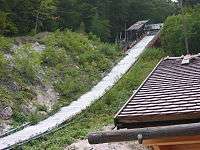 Letalnica bratov Gorišek; flying hill inrun in 2005 Other records
Four Hills Tournament
|
The greatest ever
Individual results considered only are based on ski-database.com super ranking system (updated: 26 November 2016):[29]
- Olympics, Nordic World Championships, Ski Flying World championships, World Cup (wins, other podiums and 4-10th places)
- Four Hills Tournament title, Raw Air title, FIS Ski Flying World Cup small crystal, FIS Ski Jumping World Cup overall and world records
Men |
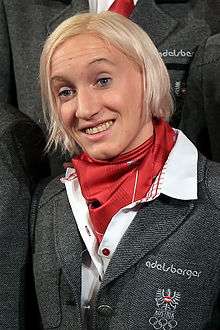 Daniela Iraschko-Stolz, only female who jumped over 200 m .jpg) Rok Urbanc; V-style (Holmenkollen 2005) 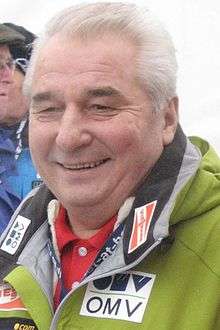 Jiří Raška (2008) Ladies
Scoring system
|
||||||||||||||||||||||||||||||||||||||||||||||||||||||||||||||||||||||||||||||||||||||||||||||||||||||||||||||||||||||||||||||||||||||||||||||||||||||||||||
Historic jumps
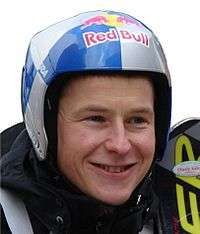
Men
| First jump | Date | Country | Hill | Place | Meters | Yards | Feet | |
|---|---|---|---|---|---|---|---|---|
| in the history | 22/11/1808 | Olaf Rye | | Eidsberg church | Eidsberg, Norway | 9.5 | 10.4 | 31 |
| over 50 metres ever | 16/02/1913 | Ragnar Omtvedt | | Wolverine Hill | Ironwood, Michigan, United States | 51.5 | 56.3 | 169 |
| over 100 metres ever (invalid) | 17/03/1935 | Olav Ulland | | Trampolino Gigante Corno d'Aola | Ponte di Legno, Kingdom of Italy | 103.5 | 113.2 | 333 |
| over 100 metres officially (stand) | 15/03/1936 | Sepp Bradl | | Bloudkova velikanka | Planica, Kingdom of Yugoslavia | 101.5 | 111.0 | 340 |
| over 150 metres ever | 11/02/1967 | Lars Grini | | Heini-Klopfer-Skiflugschanze | Oberstdorf, West Germany | 150.0 | 164.0 | 492 |
| over 200 metres ever (invalid) | 17/03/1994 | Andreas Goldberger | | Velikanka bratov Gorišek | Planica, Slovenia | 202.0 | 220.9 | 663 |
| over 200 metres officially (stand) | 17/03/1994 | Toni Nieminen | | Velikanka bratov Gorišek | Planica, Slovenia | 203.0 | 222.0 | 666 |
| over 250 metres ever | 14/02/2015 | Peter Prevc | | Vikersundbakken | Vikersund, Norway | 250.0 | 273.4 | 820 |
Ladies
| First jump | Date | Country | Hill | Place | Meters | Yards | Feet | |
|---|---|---|---|---|---|---|---|---|
| in the history | __/01/1863 | Ingrid Olsdatter Vestby | | Nordbybakken | Trysil, Norway | unknown | ||
| over 50 meters ever | __/__/1932 | Johanne Kolstad | | Gråkallbakken | Trondheim, Norway | 62.0 | 67.8 | 203 |
| over 100 meters ever | 29/03/1981 | Tiina Lehtola | | Rukatunturi | Kuusamo, Finland | 110.0 | 120.3 | 361 |
| over 150 meters ever | 05/02/1994 | Eva Ganster | | Kulm | Tauplitz/Bad Mitterndorf, Austria | 161.0 | 176.1 | 528 |
| over 200 meters ever | 29/01/2003 | Daniela Iraschko | | Kulm | Tauplitz/Bad Mitterndorf, Austria | 200.0 | 218.7 | 656 |
Tandem
| First jump | Date | Country | Hill | Place | Meters | Yards | Feet | |
|---|---|---|---|---|---|---|---|---|
| in the history | 18/02/2016 | Rok Urbanc Jaka Rus | | Planica Nordic Center HS45 | Planica, Slovenia | 35.0 | 38.3 | 115 |
Perfect score jumps: 5 x 20
Those who have managed to show a perfect jump, which means that all five judges attributed the maximum style score of 20 points for their jumps. Kazuyoshi Funaki, Sven Hannawald and Wolfgang Loitzl were attributed 4x20 (plus another 19.5) style score points for their second jump, thus receiving nine times the maximum score of 20 points within one competition. Kazuyoshi Funaki is the only one in history who achieved this more than once. So far only seven jumpers are recorded to have achieved this score in total of ten times:
Highest attendance
Single daily events with more than 50,000 people. List is not complete:

| Rank | Attendance | Location | Date | Hill | Competition |
|---|---|---|---|---|---|
| 1 | 143,000 | | 14 February 1952 | Holmenkollbakken | 1952 Winter Olympics |
| 2 | 130,000 | | 16 February 1936 | Große Olympiaschanze | 1936 Winter Olympics |
| 3 | 120,000 | | 18 February 1962 | Wielka Krokiew | 1962 FIS Nordic World Ski Championships |
| 4 | 106,000 | | March 1946 | Holmenkollbakken | The Peace Competition |
| 5 | 100,000 | | 16 March 1985 | Velikanka bratov Gorišek | FIS Ski Flying World Championships 1985 |
| 6 | 70,000 | | 22 March 1997 | Velikanka bratov Gorišek | 1996/97 FIS Ski Jumping World Cup |
| 7 | 70,000 | | 3 March 2011 | Holmenkollbakken | 2011 FIS Nordic World Ski Championships |
| 8 | 55,000 | | 20 March 2010 | Letalnica bratov Gorišek | FIS Ski Flying World Championships 2010 |
| 9 | 50,000 | | 14 March 1987 | Velikanka bratov Gorišek | 1986/87 FIS Ski Jumping World Cup |
| 10 | 50,000 | | 17 February 1998 | Hakuba Ski Jumping Stadium | 1998 Winter Olympics |
List of national records
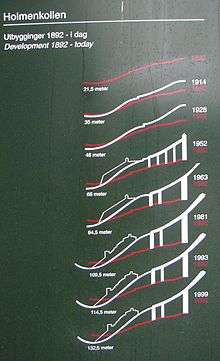
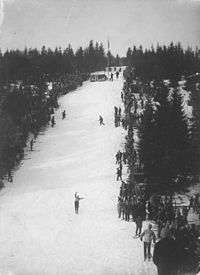
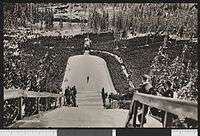
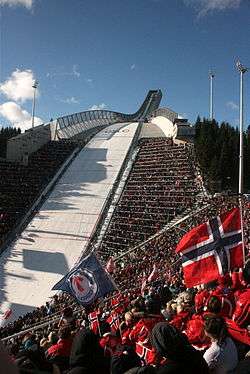
Men
| Rank | Nation | Metres | Feet | Place | Year | Source | |
|---|---|---|---|---|---|---|---|
| 1 | Anders Fannemel (WR) | |
251.5 | 825 | Vikersund | 2015 | [30] |
| 2 | Peter Prevc | |
250.0 | 820 | Vikersund | 2015 | [31] |
| 3 | Stefan Kraft | |
246.5 | 809 | Vikersund | 2016 | [32] |
| 4 | Severin Freund | |
245.0 | 803 | Vikersund | 2015 | [33] |
| 5 | Noriaki Kasai | 240.5 | 790 | Vikersund | 2015 | [34] | |
| 240.5 | 790 | Kulm | 2016 | [35] | |||
| 6 | Janne Happonen | |
240.0 | 787 | Vikersund | 2011 | [36] |
| 7 | Simon Ammann | 238.5 | 782 | Vikersund | 2011 | [37] | |
| 238.5 | 782 | Planica | 2016 | [38] | |||
| 8 | Kamil Stoch | |
238.0 | 781 | Planica | 2015 | [39] |
| 9 | Antonín Hájek | |
236.0 | 774 | Planica | 2010 | [40] |
| 10 | Dimitry Vassiliev | |
233.5 | 766 | Vikersund | 2015 | [41] |
| 11 | Vincent Descombes Sevoie | |
230.5 | 756 | Vikersund | 2016 | [42] |
| 12 | Mackenzie Boyd-Clowes | |
224.0 | 735 | Planica | 2016 | [43] |
| 13 | Alan Alborn | |
221.5 | 727 | Planica | 2002 | [44] |
| 14 | Andrea Morassi | |
216.5 | 710 | Planica | 2012 | [41] |
| 15 | Vladimir Zografski | |
213.5 | 700 | Planica | 2013 | [45] |
| 16 | Isak Grimholm | |
207.5 | 681 | Planica | 2007 | [41] |
| Choi Heung-Chul | |
207.5 | 681 | Planica | 2008 | [41] | |
| 18 | Kaarel Nurmsalu | |
204.0 | 669 | Vikersund | 2012 | [41] |
| 19 | Petr Chaadaev | |
197.5 | 648 | Kulm | 2006 | [41] |
| 20 | Radik Zhaparov | |
196.5 | 645 | Planica | 2007 | [41] |
| 21 | Martin Mesik | |
195.5 | 641 | Kulm | 2006 | [41] |
| 22 | Vitaliy Shumbarets | |
189.5 | 622 | Planica | 2009 | [46] |
| 23 | Nico Polychronidis | |
186.0 | 610 | Oberstdorf | 2013 | [41] |
| 24 | Christoph Kreuzer | |
162.0 | 531 | Planica | 2002 | [41] |
| 25 | Faik Yüksel | |
150.0 | 492 | Oberstdorf | 2000s | [47] |
| 26 | Koba Tsakadze | |
142.0 | 466 | Vikersund | 1967 | [48] |
| 27 | Bernat Sola | |
141.0 | 463 | Tauplitz | 1986 | [41] |
| 28 | Gábor Gellér | |
139.0 | 456 | Harrachov | 1980 | [41] |
| 29 | Andreas Bjelke Nygaard | |
137.0 | 449 | Lillehammer | 2000s | [41] |
| 30 | Robert Lock | |
130.0 | 427 | Park City | 2015 | [49] |
| 31 | Eduard Torok | |
128.0 | 420 | Engelberg | 2013 | [41] |
| 32 | Dmitry Chvykov | |
124.0 | 407 | Innsbruck | 2002 | [50] |
| 33 | Tian Zhandong | |
121.5 | 399 | Bischofshofen | 2004 | [51] |
| 34 | Josip Šporer | |
102.0 | 335 | Planica | 1940s | [52] |
| Kristaps Nežborts | |
102.0 | 335 | Liberec | 2012 | [53] | |
| 36 | Zbigniew Kiwert | |
86.0 | 282 | Nizhny Novgorod | 1960 | [54] |
| 37 | Skarphéðinn Guðmundsson | |
80.0 | 262 | Squaw Valley | 1960 | [55] |
| 38 | Goga Popov junior | |
62.0 | 203 | Planica | 1952 | [56] |
| 39 | Hal Nerdal | 53.0 | 174 | Squaw Valley | 1960 | [41] | |
| Chris Hellerud | 53.0 | 174 | Falun | 1974 | [57] | ||
| 40 | Dunstan Odeke | |
50.0 | 164 | Oslo | 1990s | [57] |
| 41 | Božo Čvorović | |
46.0 | 151 | Žabljak | 1960s | [58] |
| 42 | Vid Černe | |
40.0 | 131 | Jahorina | 1949 | [59] |
| 43 | Džemo Zahirović | |
36.0 | 118 | Jahorina | 1949 | [60] |
| 44 | Rembert Notten | |
35.0 | 115 | Rückershausen | 2012 | [61][62][63] |
| 45 | Richard Brown | |
35.0 | 115 | Gothenburg | 2002 | [41] |
| 46 | Hans Holm | |
23.3 | 76 | Nuuk | 1949 | [64] |
| 47 | Brian MacMillan | |
18.6 | 61 | Mount Cook | 1937 | [65] |
Ladies
| Rank | Nation | Metres | Feet | Place | Year | Source | |
|---|---|---|---|---|---|---|---|
| 1 | Daniela Iraschko-Stolz (WR) | |
200.0 | 656 | Kulm | 2003 | [66] |
| 2 | Anette Sagen | |
174.5 | 484 | Vikersund | 2004 | [66] |
| Helena Olsson | |
174.5 | 484 | Vikersund | 2004 | [66] | |
| 4 | Lindsey Van | |
171.0 | 561 | Vikersund | 2004 | [66] |
| 5 | Ulrike Gräßler | |
146.0 | 479 | Willingen | 2010 | [66] |
| 6 | Sara Takanashi | |
141.0 | 463 | Sapporo | 2011 | [66] |
| 7 | Špela Rogelj | |
140.0 | 459 | Klingenthal | 2012 | [66] |
| 7 | Irina Taktayeva | |
137.0 | 449 | [66] | ||
| 8 | Bigna Windmüller | |
133.0 | 436 | Oberstdorf | 2008 | [66] |
| 9 | Julia Clair | |
131.5 | 431 | Planica | 2014 | [66] |
| 10 | Atsuko Tanaka | |
130.0 | 426 | Courchevel | 2013 | [66] |
| |
130.0 | 426 | Oslo | 2016 | [66] | ||
| 12 | Julia Kykkänen | |
125.0 | 410 | Oslo | 2016 | [66] |
| 13 | Michaela Doleželová | |
116.5 | 382 | Courchevel | 2013 | [66] |
| 14 | Daniela Haralambie | |
115.0 | 377 | Oslo | 2016 | [66] |
| 15 | Kinga Raida | |
111.0 | 364 | Planica | 2016 | [66] |
| 16 | Wendy Vuik | |
107.0 | 351 | Oslo | 2013 | [66] |
| 17 | Virág Vörös | |
101.0 | 331 | Predazzo | 2016 | [66] |
| 18 | Tong Ma | |
99.0 | 325 | Erzurum | 2012 | [66] |
| 19 | Šarlote Šķēle | |
85.0 | 279 | Predazzo | 2013 | [66] |
| 20 | Anemarii Bendi | |
83.0 | 272 | Otepää | 2014 | [66] |
| 21 | Valentina Sderzhikova | |
80.0 | 262 | Szczyrk | 2015 | [66] |
| 22 | Guy-Lim Park | |
79.5 | 261 | Notodden | 2015 | [66] |
| 23 | Khrystyna Droniak | |
77.0 | 253 | Szczyrk | 2016 | [66] |
Currently active


Currently active and most notable ski jumpers can be found in the following lists:
Male
-
 Gregor Schlierenzauer
Gregor Schlierenzauer -
 Michael Hayböck
Michael Hayböck -
 Stefan Kraft
Stefan Kraft -
 Severin Freund
Severin Freund -
 Noriaki Kasai
Noriaki Kasai -
 Johann André Forfang
Johann André Forfang -
 Anders Fannemel
Anders Fannemel -
 Maciej Kot
Maciej Kot -
 Kamil Stoch
Kamil Stoch -
 Peter Prevc
Peter Prevc -
 Jurij Tepeš
Jurij Tepeš -
 Dimitry Vassiliev
Dimitry Vassiliev -
 Simon Ammann
Simon Ammann -
 Kevin Bickner
Kevin Bickner
Female
-
 Sarah Hendrickson
Sarah Hendrickson -
 Sara Takanashi
Sara Takanashi -
 Anette Sagen
Anette Sagen -
 Eva Ganster
Eva Ganster -
 Lindsey Van
Lindsey Van -
 Jessica Jerome
Jessica Jerome -
 Daniela Iraschko
Daniela Iraschko -
 Coline Mattel
Coline Mattel -
 Line Jahr
Line Jahr -
 Jacqueline Seifriedsberger
Jacqueline Seifriedsberger -
 Maja Vtič
Maja Vtič
Unsuccessful
They got famous for spectacular fall and rookie approach:
-
 Vinko Bogataj – Best known as "The Agony of Defeat man" because of the constant use of footage of his spectacular tumble in the title sequence of ABC's Wide World of Sports
Vinko Bogataj – Best known as "The Agony of Defeat man" because of the constant use of footage of his spectacular tumble in the title sequence of ABC's Wide World of Sports -
 Eddie "The Eagle" Edwards – Popular favourite – and last-place finisher – at the 1988 Winter Olympics. However an icon of achievement.
Eddie "The Eagle" Edwards – Popular favourite – and last-place finisher – at the 1988 Winter Olympics. However an icon of achievement.
Ski flying
See also
- List of FIS Nordic World Ski Championships medalists in ski jumping
- List of FIS Ski Jumping World Cup team events
- List of Olympic medalists in ski jumping
- List of Four Hills Tournament winners
- Medicinernes Skiklub Svartor
- FIS Ski Flying World Cup
References
- ↑ "Ski Jumping Winter Olympics Spectator's Guide by Ron Judd (13/12/2009)". The Seattle Times. Retrieved 18 May 2015.
- ↑ "Ski Jumping". International Olympic Committee. Retrieved 13 May 2015.
- ↑ Sihera, Elaine (2010-01-13). "History of Ski Jumping Winter Olympics Norway Matt Nykanen Sondre Nordheim Olaf Rye". sportinglife360.com. Helium, Inc. Archived from the original on 2014-06-06. Retrieved 2015-05-13.
- ↑ "Computational Fluid Dynamics for Sport Simulation by Martin Peters (2009)". Google. Retrieved 15 November 2016.
- 1 2 Saur, Lasse (1999): Norske ski – til glede og besvær. Research report, Høgskolen i Finnmark.
- 1 2 3 4 5 Haarstad, Kjell (1993): Skisportens oppkomst i Norge. Trondheim: Tapir.
- ↑ "Huseby competition in Oslo". skisprungschanzen.com. Retrieved 15 March 2015.
- 1 2 Kunnskapsforlagets idrettsleksikon (Encyclopedia of Sports), Oslo: Kunnskapsforlaget, 1990. ISBN 82-573-0408-5
- ↑ MacArthur, Paul J. (Mar–Apr 2011). Skiing Heritage Journal, pp. 20–25, at Google Books. International Skiing History Association. Retrieved 2015-05-22.
- ↑ "Birger Ruud: A family of ski jumpers". sports.jrank.org. Retrieved 14 March 2016.
- ↑ Ito, Shinichiro; Seo, Kazuya; Asai, Takeshi (2008). "An Experimental Study on Ski Jumping Styles (P140)". The Engineering of Sport 7. Retrieved 2015-03-09.
- ↑ Higdon, Hal (March–April 1991). Snow Country, pp. 48–51, at Google Books. Retrieved 2015-05-23.
- ↑ "5o years from K.O.P. foundation". planica.si. Retrieved 18 October 2012.
- ↑ "First time the wind and gate compensation was used jumping at World Cup event in Oberstdorf In 2010" (PDF). International Ski Federation. Retrieved 30 January 2010.
- ↑ "Fair compensation for gate and wind conditions in ski jumping – estimated from competition data using a mixed model". epec.org. Retrieved 30 January 2010.
- ↑ "Prvič v zgodovini smučarskih skokov: tekma mešanih parov" (in Slovene). szlj.si. Retrieved 16 June 2012.
- ↑ "Ski jumping hills in Mostec, Ljubljana". skisprungschanzen.com. Retrieved 12 June 2012.
- ↑ "Vtičeva in Naglič zmagovalca mešanih parov" (in Slovene). RTV Slovenia. Retrieved 16 June 2012.
- ↑ "First ever tandem ski jump in Planica on 18 February 2016". youtube. Retrieved 21 February 2016.
- ↑ "New ski brands replace Fluege.de and Elan". International Ski Federation. Retrieved 12 June 2016.
- ↑ "Innovation: Illuminated inrun-track". International Ski Federation. Retrieved 29 September 2016.
- ↑ "Development of ski jumping technique". skijumping-info.com. Retrieved 15 January 2012.
- ↑ "For Ski Jumpers, a Sliding Scale of Weight, Distance and Health". New York Times. Retrieved 11 February 2010.
- ↑ Jessica (2011-12-04). "USA's Sarah Hendrickson wins first-ever Women's Ski Jumping World Cup competition". Women's Sports & Entertainment Network. Retrieved 2015-01-28.
- ↑ "FIS MEDIA INFO: Decisions of the 45th International Ski Congress in Vilamoura/Algarve". International Ski Federation. Retrieved 14 November 2009.
- ↑ "IOC approves skicross; rejects women's ski jumping". iht.com. Retrieved 15 March 2009.
- ↑ "Female Ski Jumpers Seem Olympic Inclusion". Epoch Times. Retrieved 14 November 2009.
- ↑ "Why women can't ski jump in the Winter Olympics". Christian Science Monitor. Retrieved 14 November 2014.
- ↑ "Super Ranking for alpine skiing". ski-database.com. 15 July 2016.
- ↑ "watch Anders Fannemel set the new world record". Telegraph. Retrieved 16 February 2015.
- ↑ "Watch: Peter Prevc sets new ski jumping world record with 'perfect' leap of 250m (820 feet)". Telegraph. Retrieved 14 February 2015.
- ↑ "Austrian national record by Kraft". YouTube. Retrieved 15 February 2016.
- ↑ "Freund wins ski flying event In Vikersund and set German record". Yahoo. Retrieved 15 February 2015.
- ↑ "Japanese national record by Kasai in Vikersund". YouTube. Retrieved 15 February 2015.
- ↑ "Japanese national record tied by Kasai in Kulm". YouTube. Retrieved 15 January 2016.
- ↑ "Finnish national record by Happonen". YouTube. Retrieved 13 February 2011.
- ↑ "Swiss national record by Ammann in Vikersund". YouTube. Retrieved 13 February 2011.
- ↑ "Swiss national record by Ammann tied in Planica". YouTube. Retrieved 20 March 2016.
- ↑ "Superlotnik Stoch przesunął granicę! Rekord Polski pobity" (in Polish). tvn24.pl. Retrieved 21 March 2015.
- ↑ "Czech national record by Hájek". YouTube. Retrieved 20 March 2010.
- 1 2 3 4 5 6 7 8 9 10 11 12 13 14 15 16 "Rekordy i statystyki: Loty narciarskie". skokinarciarskie.pl (in Polish). Retrieved 12 February 2013.
- ↑ "French national record by Descombes Sevoie". YouTube. Retrieved 15 February 2016.
- ↑ "MacKenzie Boyd-Clowes becomes first Canadian ski jumper to fly past 200 metres". Calgary Harald. Retrieved 4 February 2013.
- ↑ "US national record by Alborn". usskiteam.com. Retrieved 18 February 2016.
- ↑ "Bugarian national record by Zografski". YouTube. Retrieved 20 March 2013.
- ↑ "Ukrainian national record by Shumbarets". YouTube. Retrieved 25 March 2009.
- ↑ "Turkish national record by Yüksel from 6:28–6:38". 24ur.com. Retrieved 25 March 2009.
- ↑ "Skifliegen: Zwei Weltrekorde". Arbeiter-Zeitung (in German): 10. 1967. Retrieved 12 February 2013.
- ↑ "Brits will compete in the Junior World Championships?". skijumping.pl (in Polish). 29 November 2016.
- ↑ "Results Training 1 Innsbruck, THU 3 JAN 2002" (PDF). fis-ski.com. Retrieved 12 February 2013.
- ↑ "FIS Continental Cup Competition in Bischofshofen Individual K125 Official Results" (PDF). fis-ski.com. Retrieved 12 February 2013.
- ↑ "Vas zanima, kakšen so rekordi po državah v smučarskih poletih" (in Slovene). siol.net. Retrieved 16 March 2014.
- ↑ Paweł Borkowski. "Nežborts z nowym rekordem Łotwy! Zobacz, jak skaczą Łotysze (wideo)". nicesport.pl (in Polish). Retrieved 12 February 2013.
- ↑ Henryk Mażul (May 2006). "Ptaki w locie naśladując". tygodnik.lt (in Polish). Retrieved 12 February 2013.
- ↑ "Skíðastökkið verður hápunktur leikanna". Alþýðublaðið: 16. 1960-02-28. Retrieved 12 February 2013.
- ↑ "Пред "Четирите скокалници" имаше четирикатна скокалница на Шапка". novamakedonija.com.mk (in Macedonian). Retrieved 12 February 2013.
- 1 2 Adrian Dworakowski. "Egzotyczne skoki narciarskie". skijumping.pl (in Polish). Retrieved 12 February 2013.
- ↑ "Žabljak". skisprungschanzen.com. Retrieved 12 February 2013.
- ↑ "Prva skijaška skakaonica u Palama". palelive.com (in Bosnian). Retrieved 12 February 2013.
- ↑ "ISTORIJA SKIJANJA NA JAHORINI I BIH" (in Bosnian). Retrieved 6 February 2015.
- ↑ "Neerpeltenaar kroont zich tot Belgisch kampioen schansspringen" (in Dutch). Het Belang van Limburg. 2012-06-13. Retrieved 14 June 2012.
- ↑ Broekx, Jesse (2012-06-11). "Tom Waes niet langer beste Belgische schansspringer" (in Dutch). sport.be.msn.com. Retrieved 14 June 2012.
- ↑ Van Horne, Kizzy (2012-06-14). "Twintiger snoept Belgisch record schansspringen van Tom Waes af" (in Dutch). Het Nieuwsblad. Retrieved 14 June 2012.
- ↑ "Rekord i Skihop.". Grønlandsposten. 1949-03-15. Retrieved 12 February 2013.
- ↑ "Ski-ing. Americans at Mount Cook. Durrance wins two events". Auckland Star: 15. 1937-07-27. Retrieved 12 February 2013.
- 1 2 3 4 5 6 7 8 9 10 11 12 13 14 15 16 17 18 19 20 21 22 23 24 "List of ladies personals best ski jumps" (PDF). skisprungschanzen.com. Retrieved 2 December 2016.
| Wikimedia Commons has media related to Ski jumping. |
